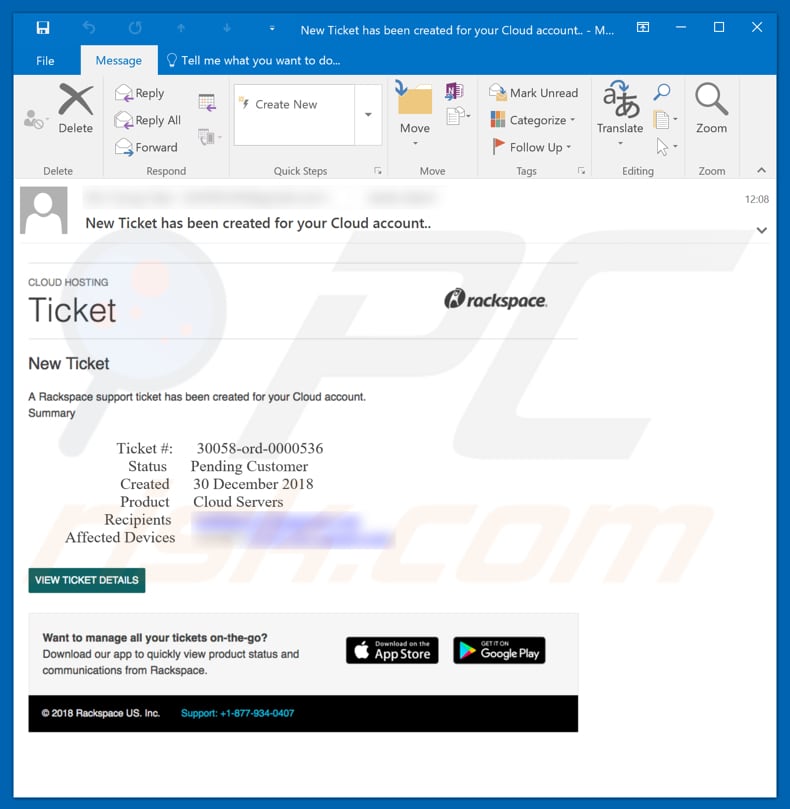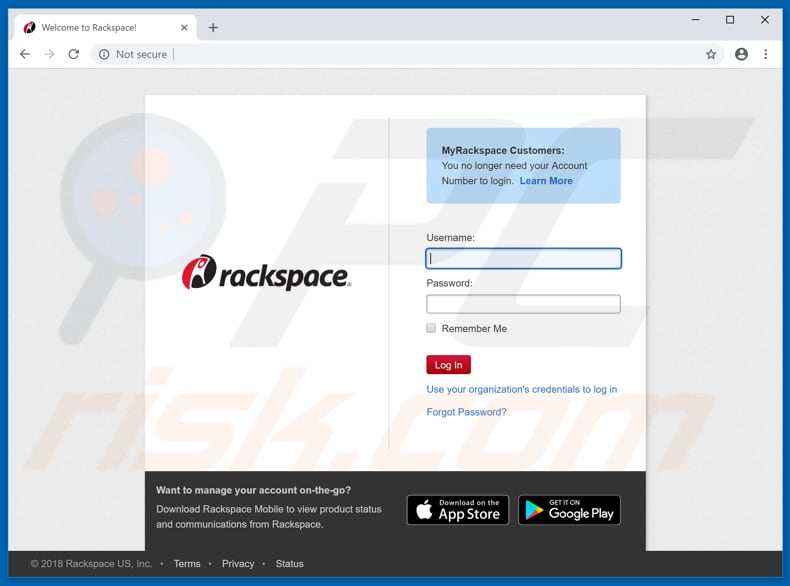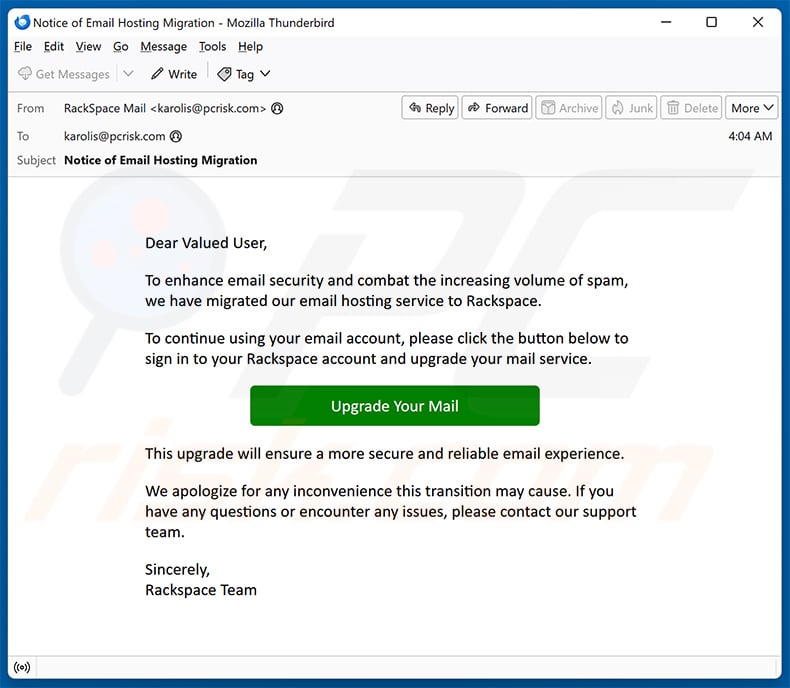Get free scan and check if your device is infected.
Remove it nowTo use full-featured product, you have to purchase a license for Combo Cleaner. Seven days free trial available. Combo Cleaner is owned and operated by RCS LT, the parent company of PCRisk.com.
What is "Rackspace Email Scam"?
Rackspace is a legitimate cloud computing company, however, some cyber criminals proliferate a spam email campaign using an identical name (so, the scam is also called "Rackspace").
The main purpose of this scam is to trick people into visiting a fake website where they are asked to enter their login and password details. Providing these details allows cyber criminals to steal them. Do not fall for the "Rackspace" scam - simply ignore the email and avoid the fake website.

"Rackspace" email scam overview
This scam is presented as an email message regarding a newly-created support ticket for a Rackspace Cloud account. It also contains details such as the ticket number and status, date it was created, and product type (in this case, Cloud Servers). It also contains a button (a website link) called "VIEW TICKET DETAILS", which leads to a fake Rackspace website.
The website asks users to enter login details and passwords of their Rackspace accounts. As mentioned above, this website is designed to steal account details, and thus you should never enter them.
Furthermore, do not log into a Rackspace account using this fake website, since it has nothing to do with the official Rackspace company. Avoid this website and do not trust these cyber criminals - ignore this and other similar spam email campaigns.
| Name | Rackspace Email Scam |
| Threat Type | Phishing, Scam, Social Engineering, Fraud |
| Symptoms | Unauthorized online purchases, changed online account passwords, identity theft, illegal access of one's computer. |
| Distribution methods | Deceptive emails, rogue online pop-up ads, search engine poisoning techniques, misspelled domains. |
| Damage | Loss of sensitive private information, monetary loss, identity theft. |
| Malware Removal (Windows) |
To eliminate possible malware infections, scan your computer with legitimate antivirus software. Our security researchers recommend using Combo Cleaner. Download Combo CleanerTo use full-featured product, you have to purchase a license for Combo Cleaner. 7 days free trial available. Combo Cleaner is owned and operated by RCS LT, the parent company of PCRisk.com. |
Spam campaigns in general
There are many different spam campaigns online. Scammers use them to trick people into providing personal details or to blackmail recipients by stating that they have obtained compromising material (humiliating photos, videos, and so on) and then to extort money from them by making threats to leak the material.
Some examples of such email scams are I Am A Spyware Software Developer, So I'm The Hacker Who Broke Your Email, and I'm A Programmer Who Cracked Your Email. Cyber criminals also use these campaigns to proliferate computer infections such as TrickBot, Emotet, AZORult, Adwind, and other viruses.
The main purpose of these emails is to trick people into downloading and opening the presented malicious attachment or a website that leads to such a file. Attached malicious files are usually MS Office documents, PDF files, archive files (such a ZIP, RAR), executables, and others.
Malicious programs distributed through these spam campaigns are often used to steal data: banking details, passwords/logins, and other personal/sensitive information. Thus, having a computer infected with viruses of this type might cause financial loss, privacy or browsing safety issues, and "backdoors" to be opened for other computer infections to exploit.
These infections are commonly trojan-type programs that proliferate other viruses such as ransomware.
We receive a great deal of feedback from concerned users about this scam email. Here is the most popular question we receive:
Q: Hi pcrisk.com team, I received an email stating that my computer was hacked and they have a video of me. Now they are asking for a ransom in Bitcoins. I think this must be true because they listed my real name and password in the email. What should I do?
A: Do not worry about this email. Neither hackers nor cyber criminals have infiltrated/hacked your computer and there is no video of you watching pornography. Simply ignore the message and do not send any Bitcoins. Your email, name, and password was probably stolen from a compromised website such as Yahoo (these website breaches are common). If you are concerned, you can check if your accounts have been compromised by visiting the haveibeenpwned website.
How do spam campaigns infect computers?
Note that spam email campaigns used to proliferate computer infections through malicious attachments (or web links) can only cause damage when permission to install a particular virus is granted. For instance, if the attached file is a Microsoft Office document, it will ask to allow to enable macro commands when opened.
If permission given, the malicious attachment can download and install a malicious program. If the presented attachment is an archive file, its contents must first be extracted, and then an executable file executed. In summary, these attachments cannot download or install any infections if they remain unopened.
How to avoid installation of malware?
Analyze received emails with care. Do not open attachments that are presented in irrelevant emails or are received from unknown (suspicious) email addresses. Download and install software with care. Check "Custom", "Advanced", and other settings/options of all download/installation set-ups.
Deselect any additionally-included applications and only then complete the process. Avoid using third party software downloaders and installers (use official sources only), since these are often used to promote rogue applications that install or download unwanted apps. Update software using tools or implemented functions provided by official software developers.
We strongly recommend that you avoid using third party software updaters, which are usually fake and dubious. Furthermore, use Microsoft 2010 or later, since these versions include "Protected View" mode that prevent malicious attachments from downloading and installing computer infections.
If you have already opened malicious attachments, we recommend running a scan with Combo Cleaner Antivirus for Windows to automatically eliminate infiltrated malware.
Text presented in the "Rackspace" email message:
CLOUD HOSTING
TICKET
New Ticket
A Rackspace support ticket has been created for your Cloud account.
Summary
Ticket #: 30058-ord-0000536
Status Pending Customer
Created 30 December 2018
Cloud Servers
Recipients **********
Affected Devices **********
View Ticket Details
Want to manage all your tickets on-the-go?
Download our app to quickly view product status and
communications from Rackspace.
© 2019 Rackspace US. Inc. Support: +1-877-934-0407
Screenshot of a deceptive (fake Rackspace) website designed to steal login and password details:

Another example of Rackspace-themed spam email:

Text presented within:
Subject: Notice of Email Hosting Migration
Dear Valued User,
To enhance email security and combat the increasing volume of spam, we have migrated our email hosting service to Rackspace.
To continue using your email account, please click the button below to sign in to your Rackspace account and upgrade your mail service.
Upgrade Your Mail
This upgrade will ensure a more secure and reliable email experience.
We apologize for any inconvenience this transition may cause. If you have any questions or encounter any issues, please contact our support team.
Sincerely,
Rackspace Team
Instant automatic malware removal:
Manual threat removal might be a lengthy and complicated process that requires advanced IT skills. Combo Cleaner is a professional automatic malware removal tool that is recommended to get rid of malware. Download it by clicking the button below:
DOWNLOAD Combo CleanerBy downloading any software listed on this website you agree to our Privacy Policy and Terms of Use. To use full-featured product, you have to purchase a license for Combo Cleaner. 7 days free trial available. Combo Cleaner is owned and operated by RCS LT, the parent company of PCRisk.com.
Quick menu:
- What is Rackspace spam?
- Types of malicious emails.
- How to spot a malicious email?
- What to do if you fell for an email scam?
Types of malicious emails:
![]() Phishing Emails
Phishing Emails
Most commonly, cybercriminals use deceptive emails to trick Internet users into giving away their sensitive private information, for example, login information for various online services, email accounts, or online banking information.
Such attacks are called phishing. In a phishing attack, cybercriminals usually send an email message with some popular service logo (for example, Microsoft, DHL, Amazon, Netflix), create urgency (wrong shipping address, expired password, etc.), and place a link which they hope their potential victims will click on.
After clicking the link presented in such email message, victims are redirected to a fake website that looks identical or extremely similar to the original one. Victims are then asked to enter their password, credit card details, or some other information that gets stolen by cybercriminals.
![]() Emails with Malicious Attachments
Emails with Malicious Attachments
Another popular attack vector is email spam with malicious attachments that infect users' computers with malware. Malicious attachments usually carry trojans that are capable of stealing passwords, banking information, and other sensitive information.
In such attacks, cybercriminals' main goal is to trick their potential victims into opening an infected email attachment. To achieve this goal, email messages usually talk about recently received invoices, faxes, or voice messages.
If a potential victim falls for the lure and opens the attachment, their computers get infected, and cybercriminals can collect a lot of sensitive information.
While it's a more complicated method to steal personal information (spam filters and antivirus programs usually detect such attempts), if successful, cybercriminals can get a much wider array of data and can collect information for a long period of time.
![]() Sextortion Emails
Sextortion Emails
This is a type of phishing. In this case, users receive an email claiming that a cybercriminal could access the webcam of the potential victim and has a video recording of one's masturbation.
To get rid of the video, victims are asked to pay a ransom (usually using Bitcoin or another cryptocurrency). Nevertheless, all of these claims are false - users who receive such emails should ignore and delete them.
How to spot a malicious email?
While cyber criminals try to make their lure emails look trustworthy, here are some things that you should look for when trying to spot a phishing email:
- Check the sender's ("from") email address: Hover your mouse over the "from" address and check if it's legitimate. For example, if you received an email from Microsoft, be sure to check if the email address is @microsoft.com and not something suspicious like @m1crosoft.com, @microsfot.com, @account-security-noreply.com, etc.
- Check for generic greetings: If the greeting in the email is "Dear user", "Dear @youremail.com", "Dear valued customer", this should raise suspiciousness. Most commonly, companies call you by your name. Lack of this information could signal a phishing attempt.
- Check the links in the email: Hover your mouse over the link presented in the email, if the link that appears seems suspicious, don't click it. For example, if you received an email from Microsoft and the link in the email shows that it will go to firebasestorage.googleapis.com/v0... you shouldn't trust it. It's best not to click any links in the emails but to visit the company website that sent you the email in the first place.
- Don't blindly trust email attachments: Most commonly, legitimate companies will ask you to log in to their website and to view any documents there; if you received an email with an attachment, it's a good idea to scan it with an antivirus application. Infected email attachments are a common attack vector used by cybercriminals.
To minimise the risk of opening phishing and malicious emails we recommend using Combo Cleaner Antivirus for Windows.
Example of a spam email:

What to do if you fell for an email scam?
- If you clicked on a link in a phishing email and entered your password - be sure to change your password as soon as possible. Usually, cybercriminals collect stolen credentials and then sell them to other groups that use them for malicious purposes. If you change your password in a timely manner, there's a chance that criminals won't have enough time to do any damage.
- If you entered your credit card information - contact your bank as soon as possible and explain the situation. There's a good chance that you will need to cancel your compromised credit card and get a new one.
- If you see any signs of identity theft - you should immediately contact the Federal Trade Commission. This institution will collect information about your situation and create a personal recovery plan.
- If you opened a malicious attachment - your computer is probably infected, you should scan it with a reputable antivirus application. For this purpose, we recommend using Combo Cleaner Antivirus for Windows.
- Help other Internet users - report phishing emails to Anti-Phishing Working Group, FBI’s Internet Crime Complaint Center, National Fraud Information Center and U.S. Department of Justice.
Frequently Asked Questions (FAQ)
Why did I receive this email?
Cyber criminals distribute these emails in massive operations - therefore, thousands of users receive identical spam letters.
I have provided my personal information when tricked by this spam email, what should I do?
If you have provided account credentials - change the passwords of all possibly exposed accounts and inform their official support without delay. And if you've disclosed other private data (e.g., ID card details, credit card numbers, etc.) - immediately contact the corresponding authorities.
I have read a spam email but didn't open the attachment, is my computer infected?
No, if you've merely opened an email - that did not result in a system infection. Malware download/installation chains are jumpstarted when the attachments or links found in spam mail are opened/clicked.
I have downloaded and opened a file attached to a spam email, is my computer infected?
If it was an executable (.exe, .run, etc.) - most likely, yes - your device was infected. However, you might have avoided it if the opened file was a document (.doc, .xls, .pdf, etc.). These formats may require extra user interaction (e.g., enabling macro commands) to start downloading/installing malware.
Will Combo Cleaner remove malware infections present in email attachments?
Yes, Combo Cleaner is designed to detect and eliminate threats. It is capable of removing practically all known malware infections. Note that performing a complete system scan is crucial - as sophisticated malicious software typically hides deep within systems.
Share:

Tomas Meskauskas
Expert security researcher, professional malware analyst
I am passionate about computer security and technology. I have an experience of over 10 years working in various companies related to computer technical issue solving and Internet security. I have been working as an author and editor for pcrisk.com since 2010. Follow me on Twitter and LinkedIn to stay informed about the latest online security threats.
PCrisk security portal is brought by a company RCS LT.
Joined forces of security researchers help educate computer users about the latest online security threats. More information about the company RCS LT.
Our malware removal guides are free. However, if you want to support us you can send us a donation.
DonatePCrisk security portal is brought by a company RCS LT.
Joined forces of security researchers help educate computer users about the latest online security threats. More information about the company RCS LT.
Our malware removal guides are free. However, if you want to support us you can send us a donation.
Donate
▼ Show Discussion